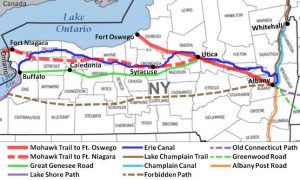 At the New York State Family History Conference held in September in Syracuse, I attended two excellent lectures about the Erie Canal: “Canal Fever: Life, Work, and Travel on the New York State Canals, 1818–1918” and “Gateway to the West: Interstate Migration on Canals,” presented by Pamela Vittorio.
At the New York State Family History Conference held in September in Syracuse, I attended two excellent lectures about the Erie Canal: “Canal Fever: Life, Work, and Travel on the New York State Canals, 1818–1918” and “Gateway to the West: Interstate Migration on Canals,” presented by Pamela Vittorio.
As someone who attended college in the Mohawk Valley region and lived in Buffalo for several years, I have certainly driven my share on the New York State Thruway. Although I get dubious looks from family, I’ve always enjoyed “hang[ing] a left at Albany” to see the incredibly beautiful countryside that borders the highway and to catch glimpses of the Mohawk River and Erie Canal. The canal played a significant role in nineteenth-century migration of families heading west from New England, and I was curious to learn about other early routes from New England.
There is a great website that has amassed information about migration routes. These routes are from and within New England, New York, Pennsylvania, and New Jersey; they include trans-Appalachian routes, southern routes, and routes to the North-Central Plains, Southwest, and Western Mountain states. The site also contains many links to maps and images. A few links are broken, but the descriptions of even those routes are helpful and provide the basis for further research.
The earliest paths were the Native American foot trails that eventually became horse paths and wagon roads. The Old Connecticut Path was the first Native American trail used by the earliest colonists of Massachusetts Bay, beginning around 1630, and it led west from the first settlements on the eastern coast. In 1635, this route was used by settlers of Watertown when they removed to Wethersfield, Connecticut. The following year, Rev. Thomas Hooker and his congregation followed the path to the Connecticut River and founded the English settlement of Hartford. The Old Connecticut Path connected with many other early migration routes such as the Kings Highway, also known as the Boston Post Road.
"The threatened penalty for unauthorized use of the trail was to be ‘burned at the stake’ or ‘roasted.’”
Another early path was the Pequot Path, a Native American trail that ran south and westward from Providence to New London, Connecticut. It was the earliest traveled highway used by the English settlers of Rhode Island.
But the path with the most intriguing name was the Forbidden Path or the Forbidden Trail. According to the website, the name of this Native American trail comes from the Seneca tribe, Keepers of the Western Door of the Six Iroquois Nations. According to an article by Albert G. Hilbert, it was a secret trail that edged the Iroquois homeland while leading west through Iroquois-controlled lands. It was “a strategic route, and for security purposes, was barred to both unfriendly or undesirable tribes and to all white men. This trail starting at Tioga Point of the Susquehanna and ending on the Allegheny River became known as the Forbidden Trail. The threatened penalty for unauthorized use of the trail was to be ‘burned at the stake’ or ‘roasted.’”
There long had been controversy regarding the location of the trail – where it went through New York and Pennsylvania – as well as whether David Zeisberger, a Moravian missionary, was the first white man to traverse the trial in 1767 and 1768. However, the trail has been definitely located in both states and can be followed closely.
The article can be read here. See also Paul A. W. Wallace, ed., The Travels of John Heckewelder in Frontier America (Pittsburgh: The University of Pittsburgh Press, 1958).
Share this:
About Nancy Bernard
Nancy holds a certificate from the Boston University Genealogical Research program. She has a master’s degree in history and media study from SUNY University of Buffalo, where she focused on American cultural history and writing and producing documentary videos. She also has a B.A. from Hamilton College. She has interned at the American Jewish Historical Society, now at NEHGS, as well as the National Heritage Museum in Lexington, MA. Her areas of interest include New England and New York history and researching house histories and the families who lived in those homes.View all posts by Nancy Bernard →